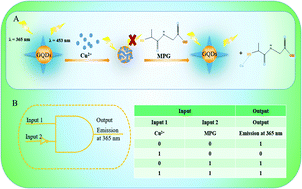Graphene quantum dots as nanosensor for rapid and label-free dual detection of Cu2+ and tiopronin by means of fluorescence “on–off–on” switching: mechanism and molecular logic gate
Abstract
A simple graphene quantum dots (GQDs)-based fluorescence sensing strategy with high selectivity and rapidity was developed for the dual detection of copper ion (Cu2+) and tiopronin (N-(2-mercaptopropionyl)glycine, MPG), therein GQDs were synthesized using citric acid (CA) via an one-step method. This GQDs fluorescence probe has good water solubility and can coordinate with Cu2+. It is found that the fluorescence of this sensor is quenched linearly with increasing concentration of Cu2+ from 0.01 to 0.5 μM. Since Cu2+ and MPG have a stronger coordination ability than that of Cu2+ and GQDs, the coordination of Cu2+ with MPG is preferentially triggered and results in the fluorescence of the system being enhanced again. Namely, in the presence of MPG, the fluorescence of the GQDs that had been quenched was found to be efficiently recovered. In this study, a molecular logic gate probe is proposed as a fluorescence response to Cu2+ and MPG. In this way, a novel fluorescence ‘‘turn-on’’ detection of MPG in the range from 0.01 to 0.4 μM is developed using this GQDs probe. Therefore, the designed probe is expected to become an efficient and reliable sensing platform to monitor Cu2+ and MPG in environmental and clinical applications.

- This article is part of the themed collection: NJC Emerging Investigators


 Please wait while we load your content...
Please wait while we load your content...